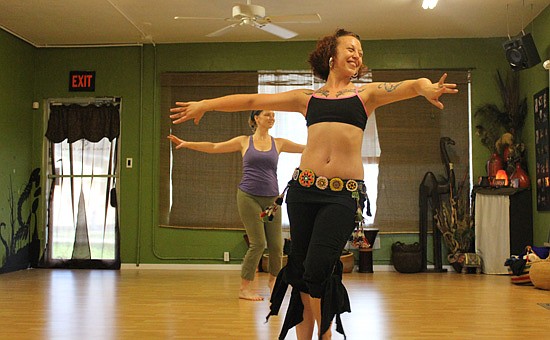- April 12, 2025
-
-
Loading

The costume goes from their bare toes up to the flowers and feathers in their hair. The tribal belly dancers wear a prairie-like skirt with layers upon layers of ruffles, and sparkly sashes with dozens of tassels tied around their waists. A quick twist of their hips sends each layer twirling. Up from there is the signature bare midriff with a coin decorated top.
The tops and bottoms of their bodies are in total control, perfectly level and still, while the middle of their bodies coil and twist in almost impossible ways. The music goes from a jazzy bass line groove to a Middle-Eastern sounding drum beat, as the dancers create atmosphere with little “yips.”
Lacey Sanchez, owner of Florida Tribal Dance (FTD) in Orlando, teaches and performs two genres of tribal belly dancing. The dance was created about 20 years ago, combining the music and moves from cultures all over the world, including African, Middle Eastern and Spanish, with a folkloric feel. When you’re watching the dancers, it’s easy to imagine it comes from an ancient culture, but the dancing and combination of moves, while referential, are something relatively new. The choreography can mix ballet, jazz, hip hop and club dancing. The options and inspirations are limitless.
“Because it’s American-made we get a lot of license to do that, it’s never a completely traditional dance,” Lacey said. “This dance is so far reaching, so global; this is something that really spans genres.”
Heavy costuming is an important element to the dance, especially for performances, and adds to the old-world feel. Lacey likes to pile on the accessories, and decorates herself with heavy, ethnic jewelry. It’s theatrical.
“I don’t feel complete unless I’m 20 pounds heavier,” she said with a laugh.
Her studio offers improvisational tribal dance, which doesn’t have a set choreography and instead has a lead dancer deciding the dance on the spot and the group follows their cued moves. She also does tribal fusion belly dance, which combines tribal moves with any other style of dance the choreographer chooses.
In her classes you’ll find mostly women, and many of the dancers have tattoos and piercings. Lacey herself has tattoos, and thick swirl plugs dangling from her ears. The tribal dance culture has drawn an alternative crowd for many years.
“It was kind of accepted for you to be different,” said Alex Sanchez, Lacey’s husband, who also owns the tattoo studio Inner Image Ink, which shares a space with the FTD studio.
But the types of people attending classes have expanded since 2006 when FTD started. Among the tattooed, there are stay-at-home moms looking for a way to treat themselves, like Aivin Diaz, whose Latin dance background didn’t prepare her for the challenges her body faces learning tribal dance.
Some dancers are lawyers and engineers finding a creative outlet. Orlando resident Matt Drury spends a lot of his time on business trips, and the first thing he does is find the tribal dance studio in the area he’s visiting. Dancers and instructors run the gamut of sizes and backgrounds, and while Drury is really the one male dancer that consistently shows, he always feels at home.
At FTD, Lacey wants people to feel welcomed with open arms, even if they wouldn’t imagine they’d fit in there – because there is no “type” of person she teaches.
Florida Tribal Dance and Inner Image Ink are both located at 825 Virginia Drive in Orlando. For more information and class schedules, visit floridatribaldance.com or call 760-403-2334.
“Dance doesn’t belong in one body,” she said.
“It makes you feel beautiful and strong,” dancer Erika Altensee said.
One reason her students say they feel comfortable is their teacher. Lacey is effusive in her dance talk – it’s a mile a minute, the passion is nearly tangible, and her husband Alex says she’s almost obsessed. She gallops across the room to change the music between dance numbers, a smile never leaves her face and she says she bonds immediately with anyone who dances – but it might be her incredibly warm personality, not just the dancing, that creates the bond.
“Here when I’m dancing, I feel loved,” said January Parker.
That’s what Lacey is after – she wants her dancers to find a home, and a new piece of themselves at FTD, just like she did with dance.
“This is where I belong,” Lacey said. “It’s the only time I’ve ever really felt myself.”